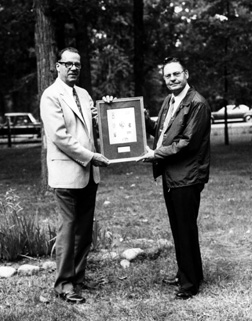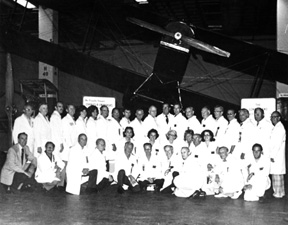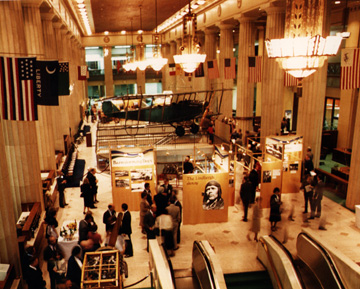Biographical Notes reCharles A. (Chuck) StonePage 2 of 5 Pages, of Chapter 13,THE LINDBERGH LEGACY |
||||||||||||
| This was particularly true of a remarkable lady by the name of Laura Jane Musser. She and I had become acquainted soon after our arrival in Little Falls, through our work in support of the Weyerhaeuser Museum and other arts-related projects. Laura Jane was the daughter of the Musser Family who were partners with the Weyerhaeusers in the Logging-Lumbering boom of the late 1800’s and early 1900’s. She was the only remaining representative of that group and was owner of all of the original Musser - Weyerhaeuser home properties in Little Falls. She had an extended history of philanthropy relating to all forms of the arts in the local area, Minnesota and, to some extent, Nationally. When she learned I had been hired as the Historic Site Manager, she would periodically ask me to drop by and brief her on our progress and special needs that had been identified that were not in the MHS budget for our site.
[Note: As I write this, Laura Jane’s property has been made available in public service under the supervision and management of the City of Little Falls, If you would like to learn more about this subject, please click here to jump over to the Linden Hill web site and return through use of your back button feature. the URL is: http://www.lindenhill.com/] At the time of the 50th Anniversary Celebration of Lindbergh’s flight from New York to Paris, The Charles A. Lindbergh Fund was established. This organization still exists with the name changed to the Charles A. and Anne Morrow Lindbergh Foundation. If you are interested in the Foundation’s history and objectives, you can skip over to their web site by clicking on this URL: http://www.lindberghfoundation.org/ By the time I became involved with the Lindbergh Historic Site, the Lindbergh Foundation was picking up speed in their stated purpose of promoting a balance between technology and the environment. |
||||||||||||
| I believe it was late winter of 1981 that I mentioned to Laura Jane that I thought it beneficial for me to attend the Lindbergh Fund Annual Awards Banquet in New York, scheduled in late May. I had mentioned that if I got that far from home, it would also be productive for me to go to Washington and do some Lindbergh research at the Air and Space Museum. She volunteered to pay the bills and I was able to attend the Banquet, and visit and overnight with George C. Dade, the person responsible for locating and restoring to flying condition Lindbergh’s original JN-4D Jenny. George had visited the historic site in the summer of 1981 to give the Interpretive Center an autographed, framed photograph of the restored Jenny. While in New York, George, after inviting me to sleep over at his home, took me to visit the Cradle of Aviation Museum on Long Island where the Jenny was on display. That evening, we attended the banquet together and he put me on an airliner to Washington the next day. This was the beginning of an ongoing relationship that took a few interesting twists. I collected a considerable number of photos at the Air and Space Museum that were added to the negatives I had been accumulating through my photo copy processing at the MHS archives and other sources. By late 1981, my collection was sufficiently extensive that I was increasingly tempted to find ways to add stories to some of the empty wall spaces at the Interpretive Center. |
||||||||||||
 |
||||||||||||
|
George Dade presents
commemorative, framed, Jenny Restoration to Lindbergh Historic Site Manager, Chuck Stone, Summer 1981. |
||||||||||||
 |
||||||||||||
|
Restoration Crew |
||||||||||||
| Typically, major exhibits built for the MHS historic sites were contracted out at considerable expense. The visions I was having involved smaller, relatively untold stories, that I could carry off using my own shop facilities. When hired, I had told the MHS staff that my shop was available to them and all they had to do was pay for materials used. Over time, this became increasingly true as I built display stands, wood frames to hang video projection equipment, and a variety of displays and frames for special displays. It was truly a labor of love on my part. Later in the summer of 1982, the Director of the MHS called me and asked if I could help him out of a jam. He and I had been working with the Lindbergh Fund to bring the Jenny from New York to Minneapolis where it would be hung in the atrium of the Northwestern National Bank, along with a display of Lindbergh memorabilia and a collection of displays relating to different elements of the Lindbergh, and the Foundation’s formation history. In this process, he had promised the Fund’s Chair of their Board of Directors that MHS would provide the exhibit at MHS cost. Due to a state budget shuffle, these funds were no longer available. He asked me if I could design and build the exhibit, with the larger eight foot high mounting panels being fabricated by the Foundation resources. I immediately agreed to do the project, as it gave me an outlet for my drive to use my newly acquired negatives and information. |
||||||||||||
| For the thirteen weeks, I managed the Historic Site with major assistance from my loyal and talented staff of remarkably resourceful and capable women, designed and received the approval for the exhibit plan, produced and mounted the enlarged photos. This meant days, evenings, weekends of continuous effort. There were times when I was falling asleep in my photo lab. The related text was printed by a new kind of machine called a computer provided through the Lindbergh Fund resources. |
||||||||||||
 |
||||||||||||
|
|
||||||||||||
|
On a Friday night, before the scheduled show opening on the Monday before Thanksgiving, I loaded the exhibit materials into our Chevy Love Pickup and headed for Minneapolis in a real snow storm. I recall that the piles of snow had covered many of the directional signs, making it even harder for a country boy to find his way into the big city. Arriving at the bank, I parked next to a large semi that contained the disassembled Jenny. I joined the crew, hauling wings, tail assembly, fuselage and smaller parts up the escalator to the second floor that would house our exhibit. We worked on into the night and eventually, with my own truck unloaded, fell into my bed at our daughter’s home in south Minneapolis. It was soon back to work for the entire team. The Jenny crew came with the Jenny from New York. These were a few of the 40+ volunteers who had actually restored the aircraft in George Dade’s remodeled basement under his leadership. We gave them a lift when needed, but concentrated on getting our exhibit mounted on the birch door panels that were being assembled under the guidance of a room layout manager.
The exhibit opened on Monday morning with participants of the Lindbergh Family, the Lindbergh Foundation, and visiting dignitaries from around the U.S. It looked just smashing, as you can see by the color photo of the exhibit, as it was just before Thanksgiving evening, 1982. Exhausted and thankful, I drove back to Little Falls to join my wife for the Thanksgiving celebration. That evening, well fed, we sat down to watch the evening news. What was the main story? IT WAS THAT THE NORTHWESTERN NATIONAL I sat in my chair in total disbelief. The building looked like a torch from about the 6th to the top floors (about 17, as I remember). The announcer told the world that the Jenny had gone up in smoke, along with the entire bank contents. After a few phone calls, I agreed to meet the Lindbergh Fund folks at the bank the next morning. We got together, on schedule, and the Fire Chief, on site, took us on a tour through the building that could be safely toured. There was Lindbergh’s Volkswagen, on the first floor, intact, though standing in a couple of inches of water. Up on the atrium level, 2nd floor, his motorcycle was intact, our exhibits were intact, all standing in an inch or more of water. Hanging from the third floor ceiling was the Jenny, ready to fly away with just a few drops of water on her. As we toured above and saw office machines melted into blobs of metal, we realized what must have happened. There was a fire stop floor at the sixth floor level. The fire had been started, supposedly by children playing with a gas torch they had found, in the wreckage of a building being torn down next door. The fire had started there, blasted across the alley through the banks windows at the sixth floor level and set everything from the sixth floor on up on fire. The air feeding the fire above, sucked fresh cool air in through out exhibit areas. Water put on the fire, ran down the stairwells and elevator shafts. We had lucked out,
|
||||||||||||
|
End of Page 2 of 5 Pages, Chapter 13 — Go to Page 3 Click below to select a destination Go to Page 1 — 2 — 3 — 4 — 5, this Chapter Chapters 1 — 2 — 3 — 4 — 5 — 6 — 7 — 8 — 9 — 10 |
||||||||||||